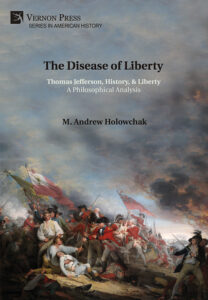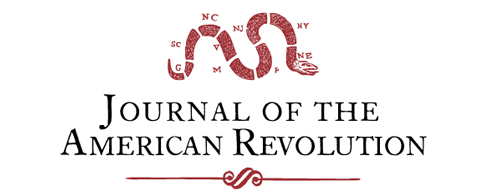BOOK REVIEW: The Disease of Liberty: Thomas Jefferson, History, & Liberty: A Philosophical Analysis by M. Andrew Holowchak (Vernon Press, 2024).
In The Disease of Liberty: Thomas Jefferson, History, & Liberty: A Philosophical Analysis, author M. Andrew Holowchak situates Thomas Jefferson’s political ideology within a philosophical framework and positions Jefferson as a great philosopher of the early national period. The book works its way through Jefferson’s concept of history and the importance of accurate study, and breaks down the ways in which Jefferson applied lessons from history to his contemporary political dilemma to arrive at the concept of a republican government. Many books have been written about Jefferson’s political ideologies, and the author acknowledges that he has a previous book covering what appears to be a similar topic. However, the mark that differentiates this book from many others is its analytical approach which is very much rooted in philosophical frameworks.
 As Holowchak notes, he has become intrigued with Jefferson’s fixation on the notion of liberty and paints a picture of Jefferson in the likeness of John Stuart Mill, wrestling with the question of how liberty can truly exist when people must also exist in a society (page x). Although unproven in history, Holowchak demonstrates how a philosophical approach allowed Jefferson to determine that a republican experiment allowed the greatest opportunity of success for the new American government. More than just a successful implementation of a republican government in America, however, Holowchak shows how Jefferson dreamed of a global network of such nations, built upon an attitude of benevolence toward one another (p, ix-x). Holowchak takes a very philosophically analytical approach to breaking down Jefferson’s reasoning behind his views for the best government structure most likely to be successful and maximize liberty.
As Holowchak notes, he has become intrigued with Jefferson’s fixation on the notion of liberty and paints a picture of Jefferson in the likeness of John Stuart Mill, wrestling with the question of how liberty can truly exist when people must also exist in a society (page x). Although unproven in history, Holowchak demonstrates how a philosophical approach allowed Jefferson to determine that a republican experiment allowed the greatest opportunity of success for the new American government. More than just a successful implementation of a republican government in America, however, Holowchak shows how Jefferson dreamed of a global network of such nations, built upon an attitude of benevolence toward one another (p, ix-x). Holowchak takes a very philosophically analytical approach to breaking down Jefferson’s reasoning behind his views for the best government structure most likely to be successful and maximize liberty.
Holowchak’s philosophical approach to Jefferson’s fixation upon the notion of liberty illuminates Jefferson’s preoccupation with revolutions, including his investment in the French revolution as well as the characterization of the election of 1800 as a revolution. Using Jefferson’s own writings, including the Declaration of Independence and his Notes on the State of Virginia, as well as Jefferson’s extensive personal correspondence, Holowchak pieces together Jefferson’s views on how liberty can best be maintained and encouraged via suitable republican governmental structure. Jeffersonian republicanism embraced individual liberty and freedom of thought in a governmental structure that encouraged political and moral maturation through an intellectual freedom that allowed a partnership with science (p. 68). Also fundamental to Jeffersonian liberty was the notion that humans were equal at a fundamental level (p. 71).
As Holowchak argues, scholars have often confused the meaning behind Jefferson’s use of liberty. Although Jefferson’s fixation on the concept and its importance to Enlightenment thinkers mean that it is repeatedly surfaces in scholarship, Holowchak contends that scholars have tended to not delve deeply into Jefferson’s notion of liberty because it is at its core a philosophical matter rather than a political one (p. 114). For Jefferson, Holowchak asserts, liberty is a driving force in the human condition, even though, like gravity, they may not be conscious of it. The only apparent difference that consciousness of liberty makes is to expedite the process of attaining a state of moral and political perfection. For Jefferson, history tells the story of this cosmic force’s work as humans advance from tribal society toward republic governments that espoused human happiness (p. 115). Holowchak also challenges other scholars’ views of Jefferson as a political relativist. While acknowledging that relativism fits with Jefferson’s beliefs that there is a right to revolution and periodic constitutional renewal, Holowchak contends that Jefferson’s commitment to human progress implies that as humans progress in morals and intelligence, their governments must also progress to keep pace with the citizenry (p. 124-125).
The type of analysis Holowchak offers in this work is certainly unique among Jefferson works, but some readers may find drawbacks to the author’s approach. In many ways, Holowchak contests modern scholarship on both Jefferson and the Revolution and criticizes their focus on the things that the Revolution did not accomplish, including abolition and equal rights for women. Rather at odds with current historiographic trends, Holowchak shifts the focus back to what the Revolution did accomplish. This approach could be welcomed or derided depending on one’s take on current scholarship trends. Furthermore, some readers may object to Holowchak’s characterization of much of Jeffersonian scholarship as sensationalistic. Overall, the book will probably appeal to readers who are more grounded in philosophy and are interested in an application of that kind of approach to Jefferson’s ideals.
PLEASE CONSIDER PURCHASING THIS BOOK FROM AMAZON IN HARDCOVER OR PAPERBACK.
(As an Amazon Associate, JAR earns from qualifying purchases. This helps toward providing our content free of charge.)





Recent Articles
New Jersey’s Revolutionary Rivalry
The Evolution of the American Declaration of Independence
The Deadliest Seconds of the War
Recent Comments
"The Evolution of the..."
This article is a gem. Sparkling. Excellent research. Wide and deep. Thank...
"The Evolution of the..."
A very interesting article, thank you! A more general question, if you...
"The Evolution of the..."
Thoroughly researched and a succinct presentation, especially given the article's breadth.